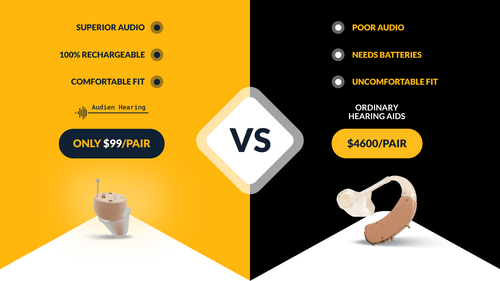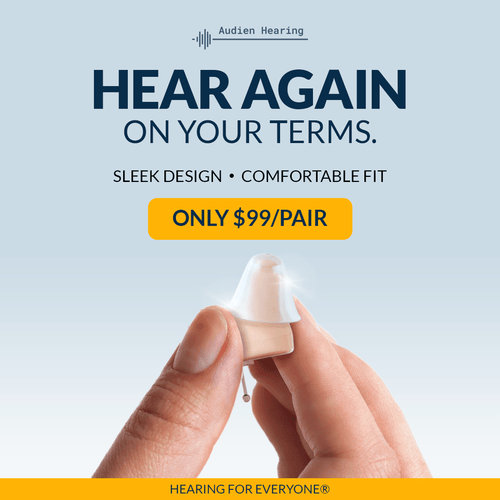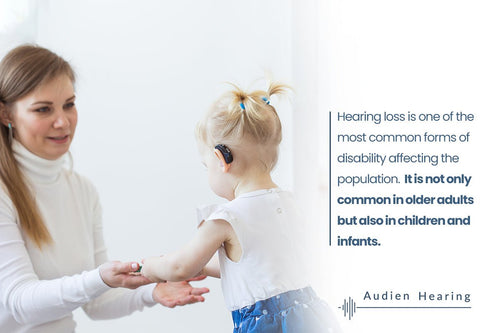Personal style is something that people strive for when it comes to appearances. Our styles and tastes are a necessary part of what makes us unique, and they are valid parts of our identity. Decisions based on our personal preferences permeate our entire lives. Even if you don’t think about fashion or style often, you still have unique self-expression in your everyday decisions.
Hearing loss is a health condition that affects a fair amount of people. That means hearing loss is one of the most common forms of disability. If you are looking for a hearing aid that is not as noticeable as your current aids, Audien Hearing may have a solution for you.
Hearing Loss Can Happen to Anyone
Hearing loss can happen naturally as you age because of health-related issues, or you can even be born with hearing defects. Our hearing ability depends on sensitive processes in our ears that allow us to receive sound wave frequencies and carry them to our brain, which interprets them as sound.

A simple reason why everyone is susceptible to hearing loss is that we all use our ears constantly. This usage naturally leads to wear on our ears that can result in deprecated hearing over time. Exposure to loud noises without proper hearing protection expedites this process and leads to an increase in hearing loss.
Not only that, but factors like traumatic injuries or even genetic factors can lead to hearing impairment or total loss. The main point is that we are all susceptible, and most people will experience hearing loss in some way, shape, or form.
How Can I Make My Hearing Aid Discrete?
If you are experiencing hearing loss, a good question to ask yourself is: What level of visibility do I want my hearing aids to have?
Although some people may not care if their hearing aid is visible or not, it all comes down to personal preference. There are lightweight and invisible options available for people who do not want it to be obvious that they are wearing hearing aids.
However, that doesn’t mean that making this decision is simple. In the world of hearing aids, multiple factors come into play beyond appearance. You should also consider functionality, processing power, along with battery life, and ease of maintenance.
The journey to finding the right pair of hearing aids isn’t just about aesthetic choice; it’s about getting a device that will help improve your hearing.
Different Kinds of Hearing Aids

Because hearing loss is one of the most prominent disabilities, it means that there is a huge market for equipment and treatment that help you improve lost hearing. The process of looking for hearing aids may be overwhelming in general.
Not only do you have many different brands and claims on the market - but there are also different styles of hearing aids to choose from. When starting to look at what hearing aid is right for you, there are several factors to consider.
For instance, there are two overarching styles of hearing aids: Behind-the-ear (BTE) and In-the-ear (ITE).
You’ll find invisible hearing aids are considered ITE-style hearing aids. In the ear hearing aids are worn very similarly to Bluetooth earphones. They hide beneath the surface of the outer ear inside the ear canal. In turn, this type of hearing aid is not readily noticeable by other people.
Let’s take a closer look at these two styles and see what they bring to the table.
Behind-the-Ear (BTE)
Behind-the-ear style hearing aids represent the largest style on the market. These devices are typically composed of two noticeable pieces connected by a wire or plastic tube.
The largest part of the device typically fits snuggly behind your ear and protects important components like processors or batteries. The receiver sits inside the ear, and both pieces can usually be seen.
The benefit of wearing BTE style hearing aids is that they typically have more processing power, battery, and multiple microphones. People who have moderately severe to severe hearing loss are more prone to have BTE style hearing aids. They typically choose this style because the larger size of the device allows for power to be used during use.
In-the-Ear (ITE)
ITE hearing aids all follow one rule of thumb: They are composed of a single piece that fits inside the ear canal itself. Even though there are multiple types of ITE hearing aids, not all of them are completely invisible.
ITE - The Largest Size
The largest style of these hearing aids is referred to as ITE. Large size ITE hearing aids have volume control and have more room for battery power. This is the best option for you if you have a large degree of hearing loss.
They are custom-fitted to your ear and can be unique to your needs. They sit in the bowl of your ear and are not invisible.
In-the-Canal (ITC) Medium Size
Another style of ITE hearing aids is the In-the-canal style aids. These hearing aids are custom molded to the shape of your ear and sit partially in your ear canal.
These medium-size ITE-style hearing aids are best for people who deal with moderate to moderately severe hearing loss.
Completely-in-Canal (CIC) Smallest Size
The last style of hearing aid is the CIC or Completely-in-Canal hearing aid. These hearing aids are designed to fit, as the name implies, completely in your hearing canal. This makes them the smallest and most discreet hearing aid on the market.
These invisible hearing aids are not noticeable. However, they have drawbacks. Their smaller size means less room for processing power, amplification, and battery power. Meaning, these devices are not suited for moderately severe or severe hearing loss. They also have the shortest battery life and are only large enough to house one microphone.
If you have minimal to moderate hearing loss, an option like CIC’s is the perfect option for you. These hearing aids are the smallest and most difficult to put in and take out. They require the use of a small string to help the wearer remove them from their ear canal.
Conclusion
Choosing a hearing aid style that is best suited for you doesn’t have to be a hard decision. Depending on your degree of hearing loss, different styles may help your hearing improve accordingly.
Audien Hearing has designed two ITE-style hearing aids. Our over-the-counter, one-size-fits-all hearing aids are made with a quality we guarantee. It’s our goal to provide you with efficient and affordable invisible hearing aids. Click here to discover more about EV1 and EV3 to see if they are best suited for your hearing needs.
“The key to finding the best solution may involve trying different styles of hearing aids. Above all, they have to work and fit well. Looks may need to be secondary.” - Drew Sutton, MD, Board-Certified Otolaryngologist.
Sources:
Hearing aids: How to choose the right one | Mayo Clinic
Degrees of Hearing Loss | Hearing Health Foundation
Hearing Loss: Hearing Aid, Causes, Symptoms, Treatment & Types | Clevelandclinic.org













